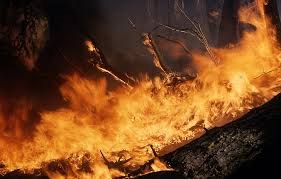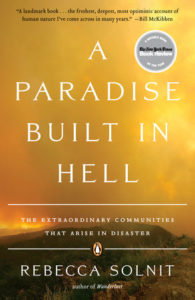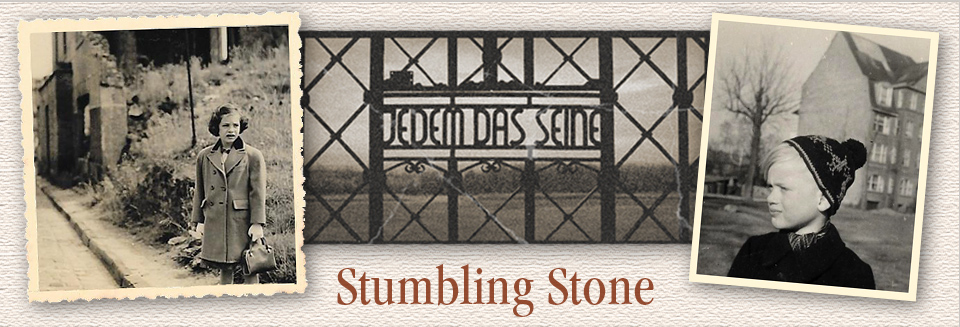Hope is Not a Strategy: What Next?
By Rudi Raab and Julie Freestone
A few weeks before the Loma Prieta earthquake (6.9) on the San Andreas Fault in California in 1989, Julie wrote an article for the local newspaper. “Ready or Not” was part of the headline and it addressed the need to make plans for the inevitable and potentially devastating earthquake in the future.
We prepared
That was the year we met and we took the advice of experts: We created earthquake kits for our cars and for our home. Every year in November, we wrote scenarios to practice what we’d do when the shaking stopped. We stockpiled water, clothes, food and other supplies. We wrote a book about disaster preparedness for businesses. We felt we were ready.

After the wild fires in California, we refined our emergency plans
And after the wild fires in California in the past two years, we refined our preparedness efforts even more. We cleared two shelves in our linen closet outside our bedroom and installed several “go kits”, documents and other items that we could literally grab on our way out. Although there is a constant drumbeat for this kind of getting ready, some people thought we were a little fanatic about the whole thing.
What about now?
In our persona; life, we did not plan for a pandemic, although both of us worked professionally on getting ready for just what’s happening now. We don’t think we actually thought it would happen.
Recently, Julie heard a radio broadcast about reopening the country and Chris Murray, the director of the Institute for Health Metrics and Evaluation said, “Hope is not a strategy.” We agree and think we need to consider what our strategy will be for reopening our lives, recognizing that getting back to “normal” may not happen quickly and maybe never at all. You can hope, but we probably need a plan.
What are we looking at?
Our friend Leslie, a lawyer who works in the public health field, raised these questions worth considering: “Your blog (about what is normal) makes it sound like you think there will be a day when this is over and things go back to ‘normal’. I don’t think that’s happening until there’s a vaccine. So the question is what do the next two years (or so) look like. Even when the SIP (shelter-in-place) order is lifted or modified, will people go to concerts or sporting events? Who will want to get on an airplane? Will we still wear masks out in public? Will there still be lines outside of the grocery store because they are limiting entry? And how many businesses won’t exist anymore because they couldn’t survive? It may be that you are free to leave your house soon but I don’t know that that really changes much in the overall scheme of things.” She is the mother of two young children, a newborn and a toddler.
And our friend Jim, in his nineties asked similar questions: “We walk a lot on various streets near our home and observe the distancing need without thinking. Will this continue?” He talked about three Zoom classes he is taking and said, “I walked or took a bus to all of these events (before the shelter-in-place). Will I want to get on a bus to participate? I don’t know. I have very little faith in so much of the news concerning the virus that decision making is difficult.”
The infrastructure and the future
Chris Murray from the Institute for Health Metrics, talking about the last outbreak with SARS, said, “There wasn’t a second wave. We don’t really know why. And it would be great if that (no second wave) occurs now, but hope is not a strategy. And given what we’ve seen about how much more widely spread Covid is than SARS-1, we should expect that the risk of a second wave is great. The vast majority of the U.S. will be susceptible. And that means that we need to be better prepared in terms of testing, contact tracing, isolation strategies.”
So that’s the blueprint for prepping the infrastructure, but how about us? It isn’t as simple as putting a kit together and doing practice scenarios. Many of us have participated in strategic planning for organizations. Maybe we need some of that effort for our lives to come. One friend observed that for many of us in our “golden years”, we don’t have time to wait at home for an indeterminate time. Do we have to construct a whole new way of living? Different things that bring us pleasure, new ways to commune with family and friends, even to acquire the things we need? Do we need to reorganize or reconstruct our homes to make staying in place easier?
Could be an opportunity to change things

Rebecca Solnit believes disasters can be positive experiences
In her 2009 book, A Paradise Built in Hell, Rebecca Solnit used case studies of disasters – including the 1985 Mexico City earthquake, the 2001 terror attacks and Hurricane Katrina – to argue that emergencies aren’t just moments when bad things get worse, or when people inevitably become more scared, suspicious and self-centered. Instead (according to an article in the Atlantic) “she foregrounded (sic) the ways in which disasters opened up human reserves of improvisation, solidarity and resolve, pockets of purpose and joy, even in the midst of loss and pain. The book was not a call to celebrate disaster – but to pay attention to the possibilities it might contain, and how it might shake us loose from old ways. In Solnit’s telling, “official” disaster responses had a tendency to muck things up by treating people as part of the problem to be managed, not an invaluable part of the solution.”
That sounds heartening, but doesn’t necessarily help us regular folks to plot a way forward but maybe it could. What do you think?
Julie Freestone and Rudi Raab wrote Disaster Preparedness: Simple Steps for Business. It was published in 1998. Maybe they should go back and rewrite it to help individuals and families plan for pandemic-type disasters.
